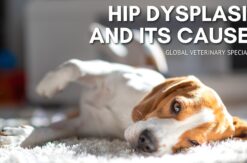Osteoarthritis (OA), also referred to as Degenerative Joint Disease (DJD), is defined as the progressive deterioration of the cartilage surrounding the joints. The American College of Veterinary Surgeons characterizes it as a loss of joint cartilage, thickening of the joint capsule, and the development of bone spurs (osteophytes). That can result in inflammation, discomfort, and decreased mobility.
Unfortunately, in the United States, about 20% of dogs over one year of age have been diagnosed with OA. If you think your dog is suffering from osteoarthritis, whether primary or secondary, you should schedule an appointment with a veterinary surgeon like Global Veterinary Specialists’ Dr. William Liska.
Contributing factors include age, breed, exercise, and weight. In terms of weight, obesity is most concerning, as increased body weight adds more stress to the joints. According to the American Animal Hospital Association, a dog is considered overweight when they are ten to 20 percent heavier than their ideal weight, which may predispose them to a significant number of conditions like osteoarthritis (McReynolds, 2020).
As with any joint problem, the body’s response attempts to stabilize laxity if it is present. When hip dysplasia is present, the degree of laxity varies from one dog to another, and there are times when one side is affected more than the other side. The laxity eventually results in secondary osteoarthritis (OA) at some point in life. Other causes include osteochondritis dissecans (OCD), a dislocated patella, elbow dysplasia, and cranial cruciate ligament disease.
Symptoms of Osteoarthritis
Your dog cannot communicate their feelings of discomfort and may even try to mask them, making it challenging to identify the symptoms of hip dysplasia and, ultimately, secondary osteoarthritis. It is often not until the orthopedic disease has progressed that pet owners report noticeable differences in their dog’s activity, behavior, or gait. A dog diagnosed with hip dysplasia, regardless of the severity, should be continuously monitored for the following common symptoms:
- Stiffness
- Lameness
- Behavioral changes
- Reluctance to play
- Decreasing appetite
- Decrease in overall activity
- Premature tiring during exercise
- Changes in gait such as “bunny hopping”
- Inability to climb stairs or jump while playing
- Avoidance of being pet since it may cause pain
In addition, it is also possible for younger dogs to temporarily improve, particularly with the changing of the seasons. That is because autumn and winter’s cooler temperatures can cause symptoms to appear more pronounced, whereas they may be more subtle during spring and summer’s warmer weather. Essentially, your dog may be able to cope better with the pain and discomfort at specific intervals, but the symptoms will likely present themselves again over time.
Diagnosis and Treatment
A veterinary surgeon can diagnose secondary osteoarthritis using the same diagnostic methods for hip dysplasia during a comprehensive orthopedic examination. The surgeon will ask questions about your dog’s diet, exercise, and genetics. They will also ask about their medical history before performing a thorough physical and orthopedic examination, including palpation of all four limbs.
Radiographic images will then be taken to confirm the diagnosis of hip dysplasia and, depending on the condition’s severity, secondary osteoarthritis. Two views, a ventral-dorsal and lateral radiograph are generally sufficient for diagnostic purposes.
If hip dysplasia and secondary OA are the diagnoses, and the dog’s quality of life is impaired, the veterinary surgeon may recommend a total hip replacement (THR). This surgical procedure replaces the abnormal joint with a prosthesis, allowing the dog or cat to resume normal, pain-free mobility. It is the most cost-effective solution in animals with moderate to severe HD and secondary OA.
Consult a Board-Certified Veterinary Surgeon
Global Veterinary Specialists recognize that dogs and cats encounter orthopedic injuries, disabling difficulties, and diseases that can impact their quality of life and are committed to restoring pain-free mobility by treating hip dysplasia and other conditions like secondary osteoarthritis.
The board-certified veterinary surgeons at Global Veterinary Specialists have extensive veterinarian and surgical experience, so you can be assured that your cat or dog is receiving excellent care.
We are teachers, mentors, inventors, clinical researchers, and veterinary surgeons committed to achieving excellent results for every patient animal we see regardless of their age or breed. We invite you to contact GVS today to learn about the treatment options for hip dysplasia so that your pet can resume a happy, healthy, pain-free life.
Resources:
Anderson, Katharine L et al. “Risk Factors for Canine Osteoarthritis and Its Predisposing Arthropathies: A Systematic Review.” Frontiers in veterinary science vol. 7 220. 28 Apr. 2020, doi:10.3389/fvets.2020.00220
McReynolds, Tony. “Pet obesity is an epidemic.” American Animal Hospital Association (AAHA). 6 Feb. 2020.
“Osteoarthritis in Dogs.” American College of Veterinary Surgeons (ACVS). N.d.
Parnell. “Osteoarthritis in Dogs – Signs and Treatment.” American Kennel Club (AKC). 17 Feb. 2021.



